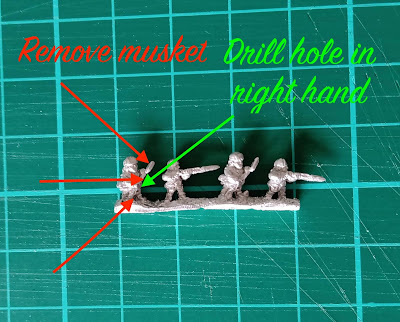The Austrian supply wagon - build instructions and suggestions.
Firstly, these instructions are intended as a guide and a record of how I built my wagons - please feel free to embellish, alter and improve to get the effect you want.
Secondly, the finish that i am aiming for is enough detail that the viewer can differentiate the wagons from each other, but these are not always going to be super realistic. They may be a foot or two longer or shorter than in real life, there may be more or less side struts than on the original, etc. If you want precision, go for 15, 28 or 54mm !
Step 0 - references. This picture of a HAT 1/72 wagon gave me the rough dimensions and outlines that I was aiming for.
7. Your wagon profile should look like this:
8. Turn the wagon over and file grooves where you want the axle to sit. The front groove needs to be shallower to compensate for the difference in wheel radius. Drill out the back of the wheels a little and superglue one wheel onto the brass rod, measure the axle length needed (measure twice!) and trim the axle so that the wheels are just proud of the wagon body - attach the second wheel. The top wagon (below) has had some stowage glued to the rear and then the luggage rack glued to the stowage and to the 1mm projections at the rear. Cut the ladder so you get two rungs.
9. The second wagon, well on the way. Cut a section from the 10mm plastic tube that is over 11mm x 6mm and trim to fit the top of the wagon, aligned flush with the rear. There will be a "shelf" at the front. Add pieces of 4mm rod on the wagon sides, using the ledge to secure them. I found this very fiddly, so I dipped one end of the rod in superglue (loctite superglue gel) and then, when I had attached all 5 struts, gave it a wash in mecpac liquid glue. At the top of the picture is a section of the large diameter plastic tube, used for the cover.
10. Final touches - there is a box on the front of the wagon - a piece of plastic rectangle cut to about 4 x 2 x 2 mm. I added a couple of 0.4 mm strip as handles.
Keep the wheels separate, so you can paint the body without them in the way.
So far - wheels "dry-fitted", stowage and front boxes added. Spare wheel will be added to one wagon. I added lateral strips to the roof - the original wagon appears to have strips with nails.
I trust that this gives you the inspiration to have a go. I certainly got a lot of pleasure from making a complete, reasonably accurate looking model from strip & rod !





























